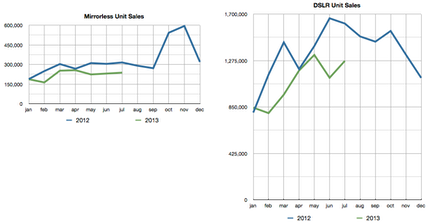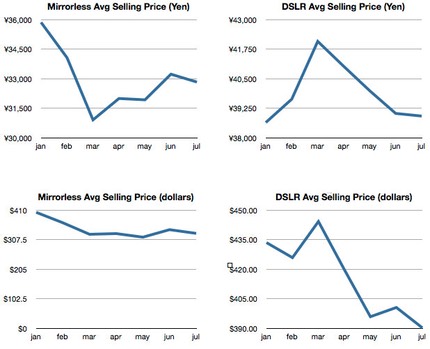(commentary)
"The number of cameras sold is going down. Shouldn't the price?"
That's a common question I've been getting lately. The answer, unfortunately, takes a whole semester's worth of MBA coursework to come up with, and even then it might be wrong ;~). Right now at every Japanese company there's a lot of calculation going on (and currency fluctuations don't help make it an easy calculation, either).
The issue for companies like Canon and Nikon is "total revenue," coupled with "total profit." Neither company wants those numbers to go down, though certainly the latter one has been drifting down on them lately.
Pricing has always been a bit of a voodoo art, even if you could assume that the world around you didn't change (no currency fluctuations, no recessions, no new technologies, no new competitors, and so on). With DSLRs, Canon and especially Nikon got seriously into "price point targeting," where they'll try to put DSLR models at carefully spaced price points with feature/performance changes that tended to encourage people to move up one model if they had the money (or credit). Inventory pileups and slow model iteration is making those price points awful fuzzy and tough to manage, though. In July, Nikon's best selling DSLR was the long-discontinued D3100, for instance, partly because Nikon has been pricing remaining inventory at a new, lower price point that tends to move people downwards ("better value") instead of the usual upwards.
But if you've noticed something about cameras lately, you've noticed there's a lot of action happening at higher and higher price points. Instead of a D400, for example, we got a D600 with more performance (FX sensor) at a higher price point. Fujifilm has basically axed all of their attempts to go low end (their previous strategy, including a push into China and India) and is now concentrating on high-end X products. Sony introduced a very high-priced full frame compact. Instead of a new Coolpix AW model, we got a Nikon 1 AW model at a much higher price point. The number of high-priced launches seems like it has increased lately.
What's going on here?
Simple answer: the Japanese appear to believe that they can move products upscale and the decrease in demand won't take away overall dollars when all is said and done. Instead of making 100 widgets that sell for US$100, they'd make 10 widgets that sell for US$1000.
In business school lingo, what we're talking about here is PED (price elasticity of demand). There are a lot of different possibilities for PED, but loosely speaking, most consumer goods tend to have a "relatively elastic" curve: in other words, if you raise prices the demand falls more so that you actually lower the amount of total revenue collected. If before you were making 100 widgets that sell for US$100, but now you're making widgets that sell for US$1000, you only sell 9, or 8, or maybe even only 5.
So the question every market analyst should be asking is this: what's the elasticity of demand for DSLRs (and to a lessor degree, mirrorless and high-end compacts)? Because if it's relatively elastic and the camera companies try to push far upwards—as Nikon did with their big FX push in 2012—ultimately the total revenue pie should fall.
Sony, with their introduction of the NEX A3000—a DSLR lookalike that's really a mirrorless NEX in disguise—at the US$400 price point for a kit, is an entirely different approach. In fact, as far as I can see, Sony is taking all approaches. They're going up, they're going down, they're going sideways, they're trying virtually every possible camera entry you can imagine. Note that even Sony is having problems with their own new entrant: last week Sony UK had to make the statement that "the A3000 launch does not signal the end of A-mount cameras." That's a very inefficient way of tackling the market, and it actually has the potential to completely backfire, as you essentially end up competing with yourself if you don't rapidly prune out the things that have lower traction.
But I'd gauge the A3000 to be a pretty interesting bet. A new DSLR-like camera (with a 20mp sensor) that's undercutting end-of-life real DSLRs such as the D3100 (and it's not 20mp ;~). Could Sony grab some of the value shoppers from Nikon's inventory clearing? I'd say yes, but Sony also has to guard against taking any of their NEX customers, too. Note that Sony switched the kit lens on the NEX-3 line to the collapsing 16-50mm. Thus, for US$100 more than the A3000 you lose the EVF and a few megapixels but gain a much smaller overall package. Interesting contrast in choices, and one that Nikon isn't really offering customers (Canon comes closer, with the EOS M, SL1, and T5i giving you three different camera options at three price points with very similar 18mp sensors and a large overlap of features).
While it's not a perfect predictor of what's happening with PED, here are the CIPA shipment numbers graphed for the first seven months of this year (an admittedly crude substitute for demand):

And here are the average selling prices (a crude substitute for retail price):

Overall, demand apparently is down (lower shipments), but average selling price isn't robust, either, indicating that the camera companies are still pushing lower end models. The retail numbers from cash registers in the US tell basically the same story: clearly lower sales, slipping average sales price.
I'm betting that we're in a market where we've hit saturation resistance, which means reduced demand. Indeed, I've been writing articles that dovetail with that thought for about 24 months, including my Last Camera Syndrome one back in February. One thing the camera makers are thinking, apparently, is that by producing higher end cameras (more full frame, higher performance cameras, feature-laden cameras, sophisticated cameras) that they'll break through some of that resistance to update and get your money again. I wish I could say that I saw strong evidence that this tactic is working, but the "word of mouth" for those high-end products seems stronger than the actual sales numbers.
Which is why I'm looking closely at, and following what happens with the Sony A3000. That's a new camera targeted at higher priced cameras (e.g. Nikon D3200), but at a comfortably lower price. If camera buying is highly elastic, that's the tactic that should work. Indeed, I believe that all those fire sales on Nikon 1 and EOS M and m4/3 end-of-life inventories prove the same thing: relatively high demand occurs with competent cameras at lower-than-DSLR prices.
What's going to happen is the classic mature market move: Canon and Nikon will eventually get more aggressive on price to keep up their overall sales numbers (and hopefully profit numbers), and this is going to eventually squeeze everyone's margins to the point where some either die or just give up.





